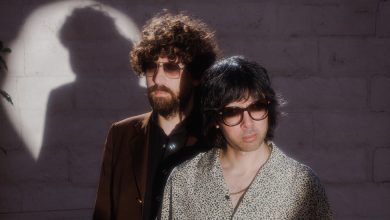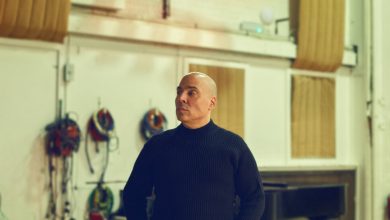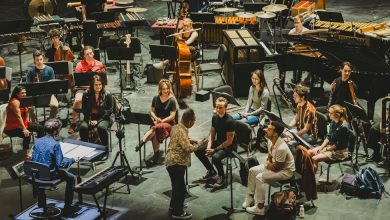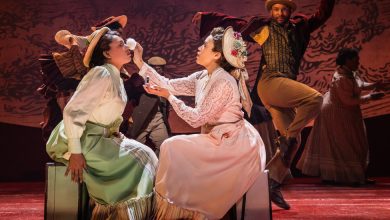Andrea Bowers: Her Activism Animates Her Art

LOS ANGELES — The artist Andrea Bowers is a workaholic who, during the depths of the pandemic, was happy to bunker in her studio here and spend hundreds of hours making a single photorealistic drawing of, say, a protester for fair wages or climate justice.
But Bowers, 56, whose art and politics are fully merged, is never more fulfilled than on the frontlines. And so she also ventured out: Joining the protests after the murder of George Floyd. Driving up the coast to embed with queer tree-sitters half her age defending redwood groves from clear-cutting in Mendocino County. To San Francisco, where she is creating an installation for the new Harvey Milk airport terminal, with disco balls and quotes in neon from the civic leader murdered in 1978.
“I’m literally making work about activism and activists,” she told me during a recent visit to her Highland Park studio. “I just offer my services, if they’re useful, and see if they’re OK with me also making some art.”
For a quarter-century, through the ever-changing social and cultural climate, Bowers has forged lasting bonds with queer and trans folk, fighters for abortion rights, radical environmentalists, immigration advocates, Native activists and scholars across generations.
“She creates her work to represent the lucha, the struggle of the people,” said the Chicago pastor and activist Emma Lozano. “From worker’s rights to immigrant rights to sanctuary, she’s been on top of it, and supporting it, making sure we get recognized through the art.”
And if her art is useful, it’s also museum-grade, shaped by the rigor of her training at the California Institute of the Arts in the early ’90s, and by intellectual engagement with second-wave feminism.
“She approaches the question of what is art’s role in addressing political and cultural issues as a distinct practice,” said the conceptual artist Charles Gaines, her friend and former teacher at CalArts.
Of her ability to make work that excels both aesthetically, by the standards of art theory, and literally as political material, he said, “I don’t know anybody who has done that as effectively.”
Now, a career-spanning survey has opened at the Museum of Contemporary Art Chicago, organized by Michael Darling, the MCA’s former chief curator, and Connie Butler, chief curator at the Hammer Museum, where it will travel in 2022. The largest-ever presentation of Bowers’s work, it offers perspective on a remarkable journey.
On a formal level, it presents her path from virtuoso, if spare, drawings in the 1990s to the present cornucopia of crafted objects and installations, textiles and neons, documentary videos, works on paper and cardboard, archival presentations and more.
But the deeper journey is a personal one: How a woman born in 1965, on the launchpad of Generation X, and raised in small-town Ohio, has navigated three decades of allyship — not without missteps — to become, arguably, America’s most important political artist.
Though she might not welcome that accolade. “I’m scared and nervous,” she said when we met, a few days before the Chicago opening. “I just want to make things.”
I found her at her red-brick studio in northeast Los Angeles, with taco trucks parked in the alley. The area is fast gentrifying, but Bowers has been here going on 30 years.
She is warm and earnest and sometimes ready to scrap. “I’m trying to be less agitational on certain levels,” she told me, suggesting it was a work in progress.
She is also generous. “She’s a friend’s friend,” said the Tijuana-based artist Marcos Ramírez, known as ERRE — always hosting gatherings and houseguests. Hospitality is a theme in her art.
In 2006-07, the church in Chicago where Pastor Lozano preached with her husband, the Rev. Walter L. Coleman, was the site of a sanctuary case: Elvira Arellano, an undocumented Mexican woman, took shelter from deportation with her young son, a U.S. citizen. Bowers visited, and produced a film from the encounter, a portrait of mother and son silently facing the camera, the altar behind them. It is on view in the new survey along with interviews with Arellano, Lozano and Coleman.
Now Bowers has invited Pastor Lozano’s group, Centro Sin Fronteras, into the MCA to curate a segment in the survey from its own archive. Working with the museum’s curator for civic and community engagement, the group picked materials from the Arellano case and other recent battles to show visitors the continued human cost of immigration policy.
For another gallery, Bowers asked members of the museum’s teenage program to select an organization to welcome. They chose A Long Walk Home, which uses art to address violence against women and girls, and which has installed a Black Girlhood Altar — with photographs, flowers, mementos — dedicated to missing and murdered Black girls.
“It’s unheard of for an artist of that caliber to share that space,” said Scheherazade Tillet, the group’s co-founder and executive director. “It’s a true intervention that’s happening in the museum.”
Lately, Bowers has ceded space in other ways too. A program billed as a “virtual studio visit” turned out to be Bowers interviewing the Native activist, Tokata Iron Eyes — whom she met at the Standing Rock protests in North Dakota and featured in a documentary — and the Native scholar Kaitlin Reed.
“That is a studio visit, because that is how I make my work,” Bowers told me. “Asking questions is the beginning of every project.”
The questioning started early. When she was growing up in Huron, Ohio, on Lake Erie, the community culture planted seeds.
In the mornings, her father, a high school shop teacher, would gather at the house with his friends, who worked in automobile plants. “They would come over and talk politics and union stuff,” she recalled. “And I’d argue with them as a very young girl.”
Her mother would check newspapers to learn if the lake was safe that day. In 1969, the Cuyahoga River caught on fire when toxic sludge ignited where it enters the lake in Cleveland. “I actually want to make work about that,” Bowers said. Lately she has met with activists fighting the algae blooms, from manure and fertilizer, that are a recurring scourge on Lake Erie.
An art major at Bowling Green State University, Bowers made her way to New York in 1987. She lived in Hoboken, N.J., and worked in downtown galleries.
“I didn’t understand it, but I was going to every opening in SoHo,” she said. Kate Eriksen and Mel Ziegler, fellow Midwesterners, “were doing all these socially engaged projects; I was obsessed with their work.” They were CalArts graduates. The school offered the conceptual emphasis she craved.
Los Angeles was then an affordable place to set up as an artist. Her crew included Gaines and fellow students Rodney McMillian and Sam Durant, along with Edgar Arceneaux and — in Tijuana — Ramírez and Lucía Sanromán.
In the 1990s, Bowers’s art centered on drawing, including extraordinary photorealist works based, for instance, on a single figure picked out from a crowd photograph of a rally or sporting event. But soon the work grew more varied, pushed by political purpose.
Upon learning of the Army of Three — Bay Area feminists who helped women find safe abortions in the years before Roe v. Wade — she visited and interviewed one of the three, Pat Maginnis, who shared a trove of letters the group had received in the late 1960s, with names redacted, from women, their partners or parents, desperate for such assistance.
Shown in 2005, “Letters to an Army of Three” is one of her finest works, appearing in Chicago as a wall of enlarged letters in a checkerboard pattern with sections of decorative wrapping paper — an inspired weave of wrenching human story and graphic form.
In 2011, Bowers got arrested in a tree. It would prove a pivotal point in her art and politics.
She had been friends with John Quigley, a noted California tree-sitter protesting the toll of suburban development, since his stand in 2003 near CalArts. This time she went up with him to protest the clear-cutting of old-growth oaks in another Los Angeles suburb. They stayed on their platforms as the trees around them were bulldozed out of the earth.
Bowers filmed not only the dramatic tree-sit, but also her first climbing lesson from Quigley. Later, she made a drawing of her arrest mug shot. (Jailed for two days, the group pleaded no-contest and was sentenced to community service.)
Bowers told me that among tree-sitters and other activists she felt “more accepted than I did in the art world.” She had also began to place herself in the frame.
The tree videos give off a liberated energy. “She turns the camera on herself, rather than the kind of almost-voyeurism of her early drawings,” said Butler, the curator. “I think Andrea understood that it’s all-or-nothing if you’re going to make this kind of work.”
Crossing this Rubicon, Butler noted, reflected the influence of Suzanne Lacy, the pioneering social-practice artist who orchestrates and participates in projects that can involve hundreds of people. The two artists had met a few years earlier, part of Bowers’s habit of “stalking” feminist elders, including Judy Chicago.
Lacy invited Bowers to teach in the Public Practice M.F.A. program she had founded at the Otis College of Art and Design. (Lacy is now at the University of Southern California; Bowers still teaches at Otis, where she helped lead the adjunct-faculty union organizing drive, winning pay raises and more secure contracts.)
“She’s like my mentor,” Bowers told me — but the two taught each other. In 2014, they camped out for a week in tents inside the Drawing Center in New York. By day, Bowers taught Lacy to draw; in the evening they held conversations with guests like Martha Rosler and Carolee Schneemann.
Lacy returned the favor in Los Angeles in 2016, giving Bowers performance lessons.
“Andrea and I explored this relationship between what she expected of people in my generation, and what we really were,” Lacy said, adding, “We didn’t take ourselves as seriously, by and large, as Andrea’s generation took us.”
Their friendship has helped Bowers view some aspects of ’70s feminism with a kinder eye, especially its magic and ritual tendencies. At the same time, Butler said, “She’s participating in a kind of revision of the history that she is part of.”
On the other hand, Bowers acknowledges the entitlements of identity that come with being a white woman in the feminist movement.
“I’m definitely a white woman and that definitely comes with privileges,” she said. “You keep trying, learn from your mistakes, learn from the people around you.” She added: “It’s either quit or try.”
The values Bowers espouses extend to her relationships with the art market. She directs part of her profits to organizations or individuals involved in the work, and asks her galleries and collectors to do the same.
“She has been doing this for 20 years,” said Susanne Vielmetter, the Los Angeles gallerist who, along with Andrew Kreps in New York, has represented her the longest.
When Bowers got in trouble in 2019, it was not over her identity, but for work she made in support of the #MeToo movement. At Art Basel in Switzerland, she presented an installation made of 167 panels, each one presenting the case of a person accused of sexual misconduct. Texts cited the person’s response to an accusation. There were photographs, too, mostly showing the accused.
One panel, however, contained an image of an alleged victim, Helen Donahue, taken from her own social media feed. Donahue complained that she had not given consent, as did another woman named (though not pictured) in the same panel. Bowers apologized, removed that panel from the work, then removed the work itself from circulation. It is now rolled up in her studio.
“I made a mistake,” Bowers told me. “I screwed up in that panel.”
In retrospect, she said, her own experiences with sexual violence may have caused her to lose “objective distance.” But it’s also noteworthy that this work, researched indirectly from news sources, deviated from her regular method of interviews and activist immersion.
By contrast, when she looked into the rape of a young woman by high-school football players in Steubenville, Ohio, in 2012, she visited the city, met the protesters and attended the players’ trial. In addition to drawings, she produced a searing video and installation, “#sweetjane” (2015), which has been omitted from the Chicago survey.
“It could be triggering or retraumatizing,” Darling, the curator, told me. But the decision reads as an excess of caution, keeping from view one of Bowers’s most powerful projects.
.
The cultural terrain is shifting, and Bowers said she is still finding her footing. “I feel like everyone in my generation is trying to understand the younger generation’s relationship to trauma,” she said.
“I come from the age of appropriation; I come from no censorship of art at all costs,” she added. “And now that’s not the same: Someone’s trauma is more important that the censorship of an artwork. I’m in that shift, and I’m thinking about it.”



